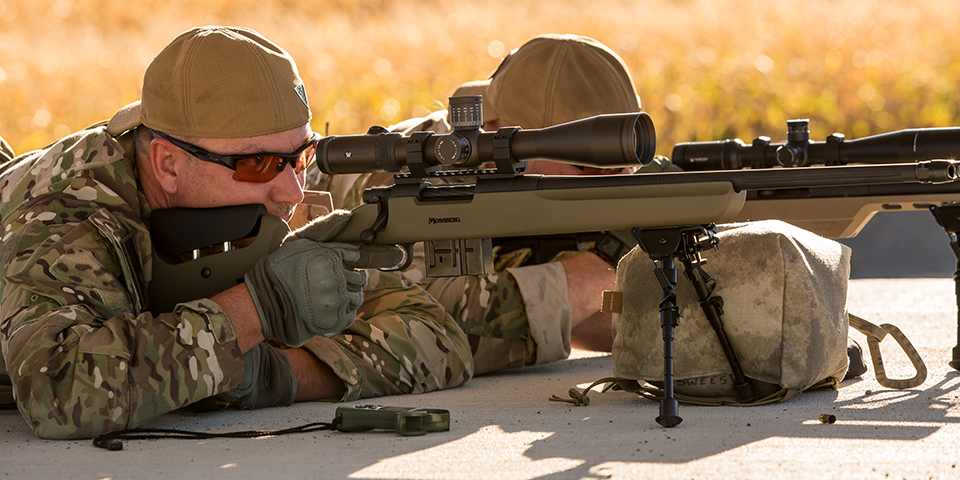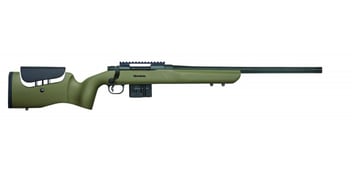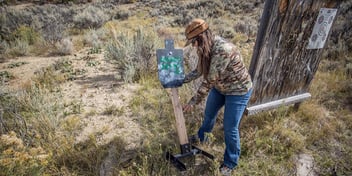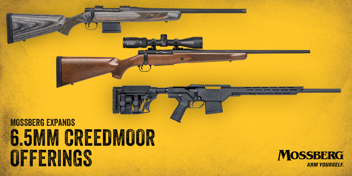
The key to mastering the art of long-range shooting are not particularly difficult to identify. They are, however, difficult to master without the presence of experienced guidance or the dedication to tireless practice. With those thoughts in mind, here are several long-range shooting tips on how to begin your quest to expert marksmanship:
1. Fit the rifle to yourself
Without a doubt, this is the single most important factor when it comes to gaining accuracy in long-range shooting. If you forget this step in the process, you might as well ignore the rest of the tips to follow. Long-range shooting relies upon establishing consistency--and more particularly upon establishing a consistent attachment to the rifle every time you bring it to your shoulder.
MVP LR and LR Tactical stocks feature an integrated Mosscote™ rubberized cheekrest that provides vertical adjustment of up to 1.5” with the push of a button and cast adjustment of up to 1/4” to ensure proper scope-to-eye alignment.
2. Align your body with the scope
Similarly, you must align your body with the scope consistently to achieve maximum accuracy on the first shot. Your body should be squarely positioned directly behind the stock to absorb the recoil of that first shot without throwing you out of position for subsequent ones.
3. Adjust the ocular
Focusing your eyepiece is primarily dependent on you as the user. In other words, you MUST make the adjustments yourself instead of someone else doing it for you. Focus the reticle while looking at a clear sky or a blank wall for the best results. Also remember to avoid looking at the reticle itself while adjusting, or your results will be substandard.
4. Tackle parallax before it tackles you
Like focusing, parallax is the other sighting factor that needs to be adjusted at every distance. Just accept this fact and realize that it just takes a little practice to master. Always watch for that slight waviness in the reticle--turn the parallax adjustment all the way out to infinity and then calmly bring it back in focus.
5. Mount the scope properly
Of all the long-range shooting tips, this is one of those seemingly trivial matters that many shooters take for granted. The scope should be installed to ensure that the reticle is absolutely horizontal. Otherwise, the shooter will have to deal with a whole host of problems associated with the relationship of their aim to the actual trajectory of the bullet.
6. Compute and adjust the BDC reticle
A lot of the tedious calculations are done for the shooter with the nifty piece of technology known as the bullet drop compensating scope. Still, the shooter must correctly input the particular caliber being shot and at what specific elevation for the most accurate results. If possible, take your practice shots on-site to fine-tune this particular adjustment.
7. Understand the adjustment dials
The farther away you plan on shooting, the more adjustments you'll need to make. It takes a lot of practice and empirical experience – that means practice! - to truly understand and be able to manipulate the adjustment dials on your scope.
8. Compensate for wind
Shooting in the wind is more of an art than it is a science; although, the tools of the trade do make a tremendous difference in being successful at it. Really, the only true way to begin mastering long-range shooting in windy conditions it is to spend a lot of time doing it. But hey--it is also a lot of fun mastering this aspect of the sport.
9. Calm your body
One of the first things that any new shooter is taught is how to control their breathing. “Fire at the bottom of your exhale”--you've probably heard it a thousand times, and if not, you certainly will as you continue learning. Your body is most relaxed at this point, and it gives you a standard reference point for all further shots. Do not hold this position for too long, though; if the shot is not fired immediately, it can cause tenseness and fatigue. Just wait, take another breath, and then fire.
10. Complete the trigger follow-through
Believe it or not, the shot is not over once the trigger is pulled. You can still have an effect on the bullet for that brief millisecond as it leaves the barrel – so stay still. Also remember to keep in position until the shot strikes the target as you may need to take a second shot.
11. Have patience
As the saying goes, “Good things come to those who wait.” The mastery of long-range shooting is no exception. With practice and a little tenacity in learning your craft, an inexperienced shooter can become an expert marksman in as little as a year. Learning to shoot at long-range may seem like a daunting challenge but it need not be so. Follow these simple long-range shooting tips and you'll be well on your way to shooting like a pro.
Extra Help:
- If you really don't have the time, then we suggest you read our post on "How to Sight a Rifle in Two Shots"
- Read our post on "Understanding Minute of Angle (M.O.A.)"
- Download these free printable rifle targets at 25, 50, and 100-yard lengths
This article provided by Mossberg contributing writer, Hilary Lloyd.




